Formulating Compensation Strategy
VerifiedAdded on 2023/01/20
|12
|2611
|32
AI Summary
This document provides a comprehensive overview of the steps involved in formulating a compensation strategy. It discusses the goals of an organization's reward and compensation system, the methods for establishing base pay, and the nature of individual performance pay plans. It also covers the steps needed for designing an effective reward system, the difference between extrinsic and intrinsic rewards, and the importance of structural and contextual variables in the workplace. Additionally, it explores the fundamental job attitudes and their role in determining employee behavior, the difference between content and process theories of motivation, and the types of employee stock plans.
Contribute Materials
Your contribution can guide someone’s learning journey. Share your
documents today.
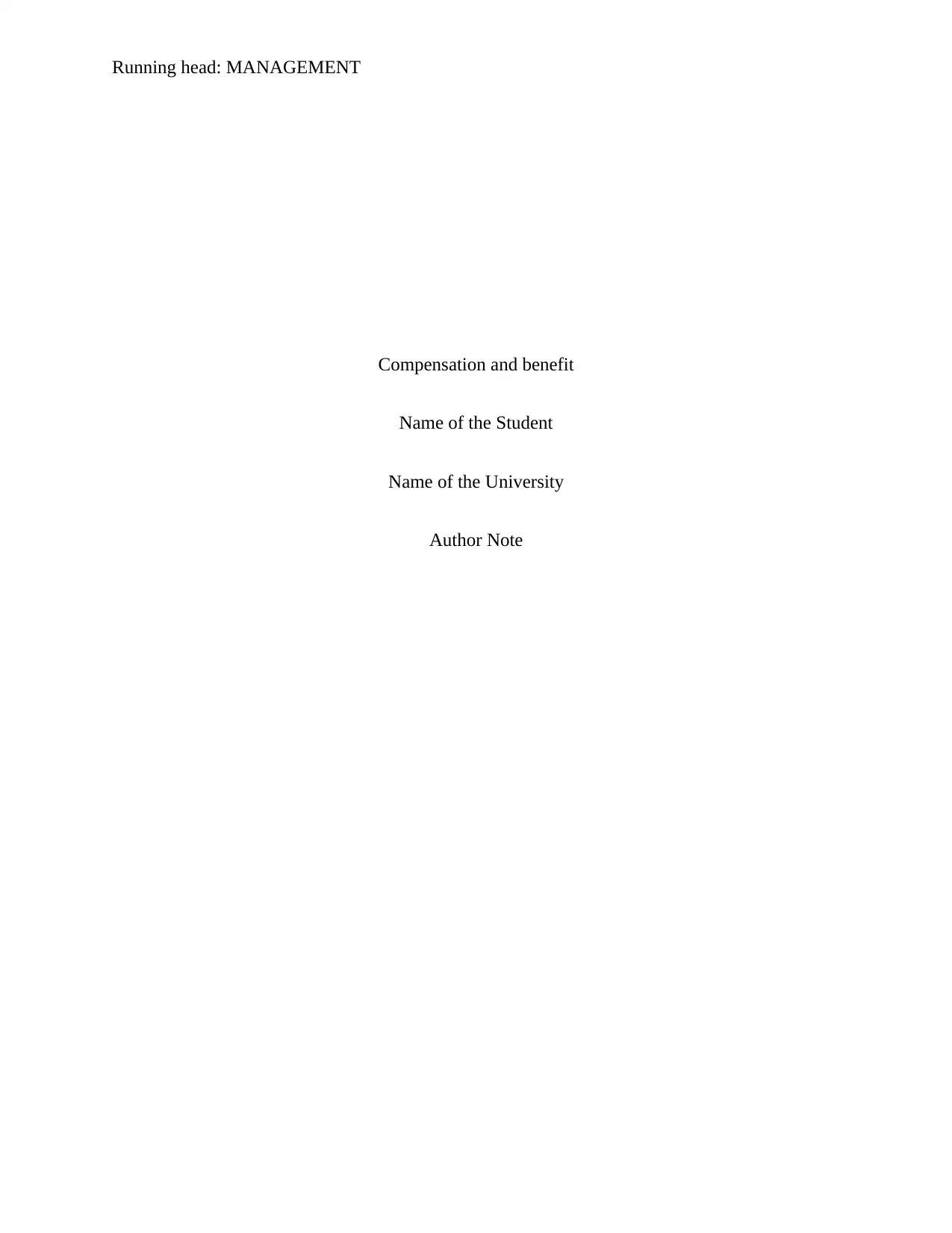
Running head: MANAGEMENT
Compensation and benefit
Name of the Student
Name of the University
Author Note
Compensation and benefit
Name of the Student
Name of the University
Author Note
Secure Best Marks with AI Grader
Need help grading? Try our AI Grader for instant feedback on your assignments.

1MANAGEMENT
Table of contents
Brief description of the steps involved in the formulation of compensation strategy.....................2
Goals of an organization’s reward and compensation system.........................................................3
Brief explanation of the three methods for establishing base pay...................................................3
Identification and explanation of the nature of individual performance pay plans.........................4
Steps needed for designing an effective reward system..................................................................4
Difference between “extrinsic” and “intrinsic” rewards.................................................................5
Importance of the structural and five contextual variables in a workplace.....................................5
Identification of the fundamental job attitudes and their roles in determining employee behavior 6
Brief explanation of the difference between content theories of motivation and process theories
of motivation....................................................................................................................................6
Difference between goal-sharing and gain-sharing plans................................................................7
Brief description of the three main categories of performance pay.................................................7
Similarities and difference between "direct" and "indirect" pay.....................................................8
Concept of FIT.................................................................................................................................8
Identification and explanation of the types of employee stock plans..............................................9
Discussion........................................................................................................................................9
References......................................................................................................................................11
Table of contents
Brief description of the steps involved in the formulation of compensation strategy.....................2
Goals of an organization’s reward and compensation system.........................................................3
Brief explanation of the three methods for establishing base pay...................................................3
Identification and explanation of the nature of individual performance pay plans.........................4
Steps needed for designing an effective reward system..................................................................4
Difference between “extrinsic” and “intrinsic” rewards.................................................................5
Importance of the structural and five contextual variables in a workplace.....................................5
Identification of the fundamental job attitudes and their roles in determining employee behavior 6
Brief explanation of the difference between content theories of motivation and process theories
of motivation....................................................................................................................................6
Difference between goal-sharing and gain-sharing plans................................................................7
Brief description of the three main categories of performance pay.................................................7
Similarities and difference between "direct" and "indirect" pay.....................................................8
Concept of FIT.................................................................................................................................8
Identification and explanation of the types of employee stock plans..............................................9
Discussion........................................................................................................................................9
References......................................................................................................................................11
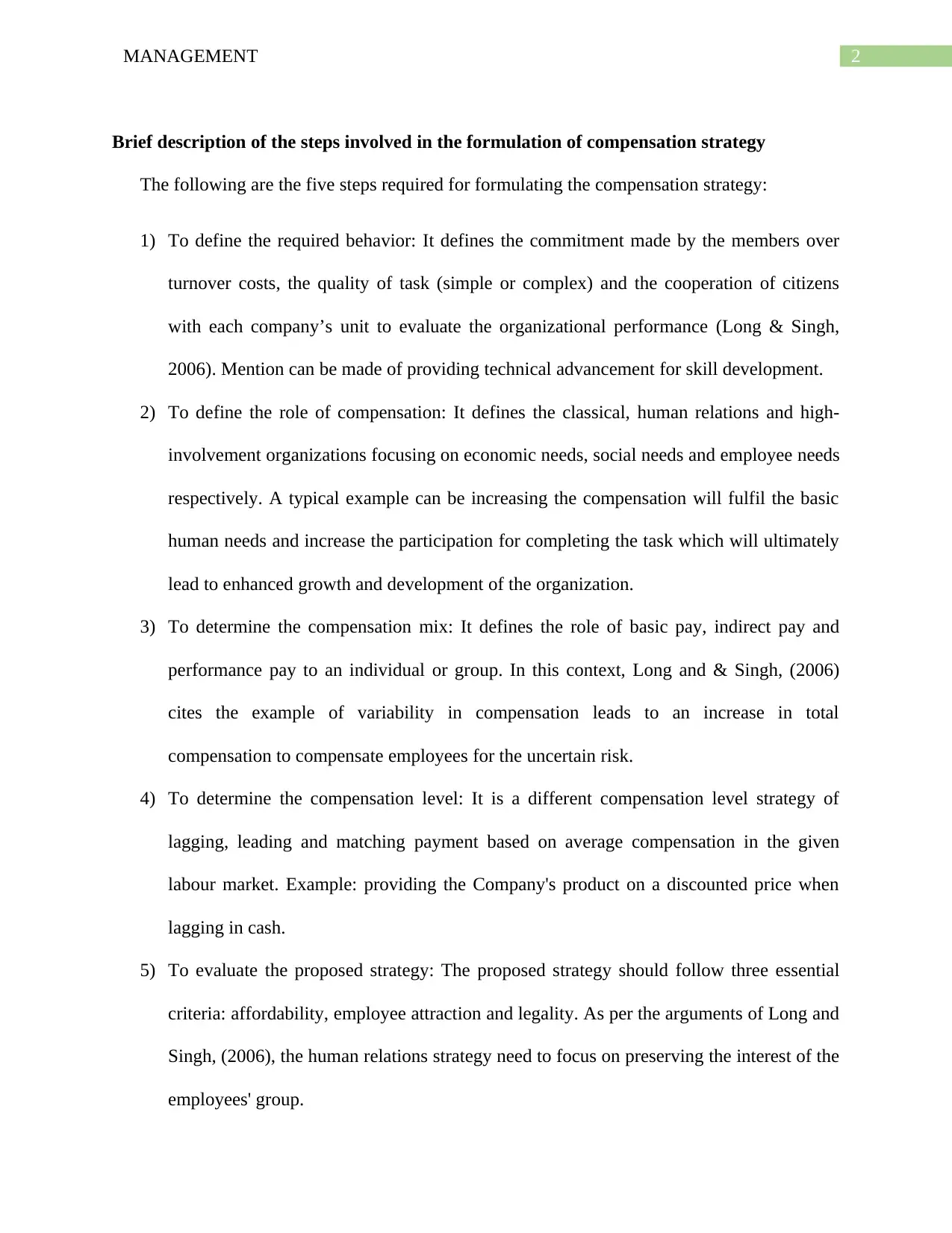
2MANAGEMENT
Brief description of the steps involved in the formulation of compensation strategy
The following are the five steps required for formulating the compensation strategy:
1) To define the required behavior: It defines the commitment made by the members over
turnover costs, the quality of task (simple or complex) and the cooperation of citizens
with each company’s unit to evaluate the organizational performance (Long & Singh,
2006). Mention can be made of providing technical advancement for skill development.
2) To define the role of compensation: It defines the classical, human relations and high-
involvement organizations focusing on economic needs, social needs and employee needs
respectively. A typical example can be increasing the compensation will fulfil the basic
human needs and increase the participation for completing the task which will ultimately
lead to enhanced growth and development of the organization.
3) To determine the compensation mix: It defines the role of basic pay, indirect pay and
performance pay to an individual or group. In this context, Long and & Singh, (2006)
cites the example of variability in compensation leads to an increase in total
compensation to compensate employees for the uncertain risk.
4) To determine the compensation level: It is a different compensation level strategy of
lagging, leading and matching payment based on average compensation in the given
labour market. Example: providing the Company's product on a discounted price when
lagging in cash.
5) To evaluate the proposed strategy: The proposed strategy should follow three essential
criteria: affordability, employee attraction and legality. As per the arguments of Long and
Singh, (2006), the human relations strategy need to focus on preserving the interest of the
employees' group.
Brief description of the steps involved in the formulation of compensation strategy
The following are the five steps required for formulating the compensation strategy:
1) To define the required behavior: It defines the commitment made by the members over
turnover costs, the quality of task (simple or complex) and the cooperation of citizens
with each company’s unit to evaluate the organizational performance (Long & Singh,
2006). Mention can be made of providing technical advancement for skill development.
2) To define the role of compensation: It defines the classical, human relations and high-
involvement organizations focusing on economic needs, social needs and employee needs
respectively. A typical example can be increasing the compensation will fulfil the basic
human needs and increase the participation for completing the task which will ultimately
lead to enhanced growth and development of the organization.
3) To determine the compensation mix: It defines the role of basic pay, indirect pay and
performance pay to an individual or group. In this context, Long and & Singh, (2006)
cites the example of variability in compensation leads to an increase in total
compensation to compensate employees for the uncertain risk.
4) To determine the compensation level: It is a different compensation level strategy of
lagging, leading and matching payment based on average compensation in the given
labour market. Example: providing the Company's product on a discounted price when
lagging in cash.
5) To evaluate the proposed strategy: The proposed strategy should follow three essential
criteria: affordability, employee attraction and legality. As per the arguments of Long and
Singh, (2006), the human relations strategy need to focus on preserving the interest of the
employees' group.
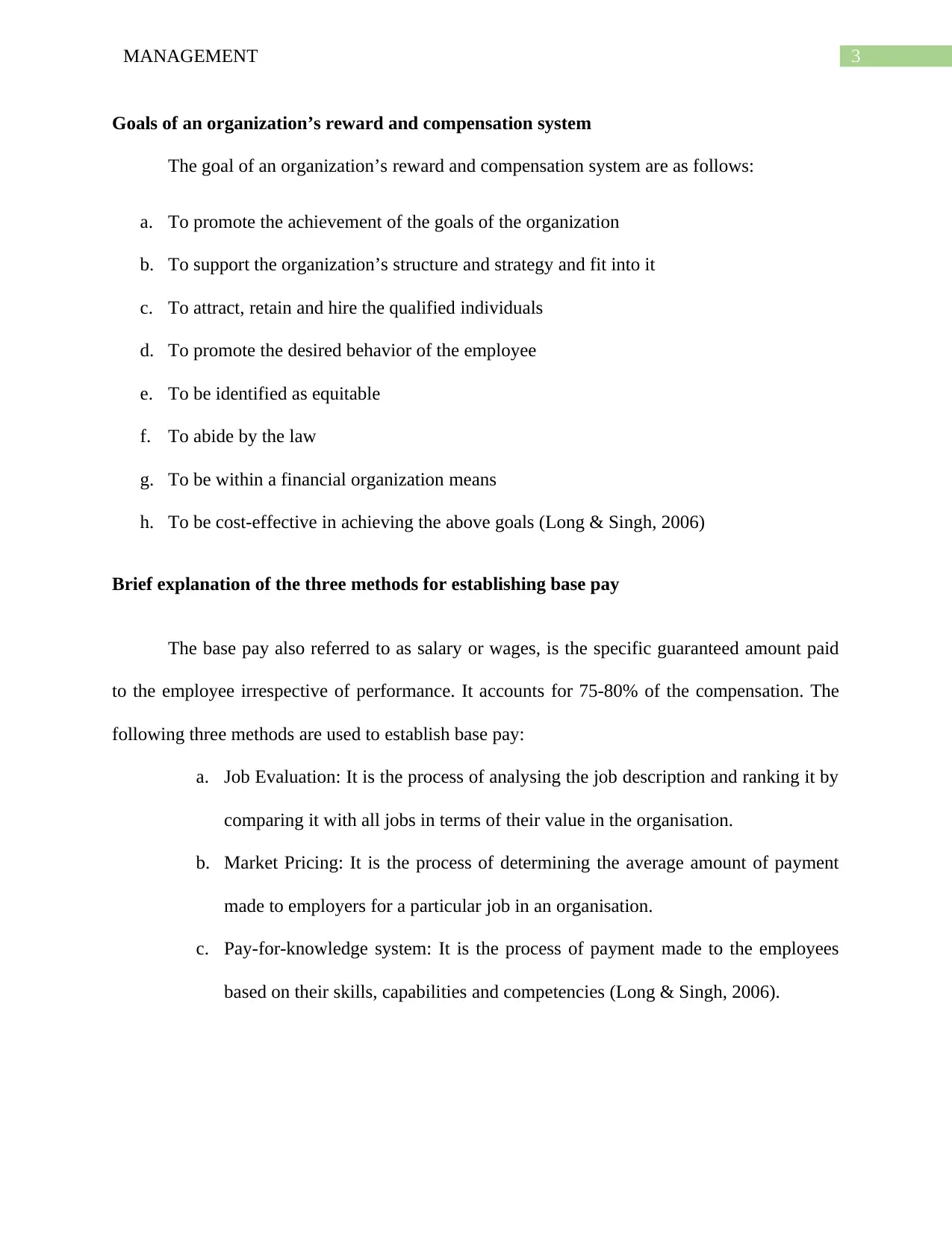
3MANAGEMENT
Goals of an organization’s reward and compensation system
The goal of an organization’s reward and compensation system are as follows:
a. To promote the achievement of the goals of the organization
b. To support the organization’s structure and strategy and fit into it
c. To attract, retain and hire the qualified individuals
d. To promote the desired behavior of the employee
e. To be identified as equitable
f. To abide by the law
g. To be within a financial organization means
h. To be cost-effective in achieving the above goals (Long & Singh, 2006)
Brief explanation of the three methods for establishing base pay
The base pay also referred to as salary or wages, is the specific guaranteed amount paid
to the employee irrespective of performance. It accounts for 75-80% of the compensation. The
following three methods are used to establish base pay:
a. Job Evaluation: It is the process of analysing the job description and ranking it by
comparing it with all jobs in terms of their value in the organisation.
b. Market Pricing: It is the process of determining the average amount of payment
made to employers for a particular job in an organisation.
c. Pay-for-knowledge system: It is the process of payment made to the employees
based on their skills, capabilities and competencies (Long & Singh, 2006).
Goals of an organization’s reward and compensation system
The goal of an organization’s reward and compensation system are as follows:
a. To promote the achievement of the goals of the organization
b. To support the organization’s structure and strategy and fit into it
c. To attract, retain and hire the qualified individuals
d. To promote the desired behavior of the employee
e. To be identified as equitable
f. To abide by the law
g. To be within a financial organization means
h. To be cost-effective in achieving the above goals (Long & Singh, 2006)
Brief explanation of the three methods for establishing base pay
The base pay also referred to as salary or wages, is the specific guaranteed amount paid
to the employee irrespective of performance. It accounts for 75-80% of the compensation. The
following three methods are used to establish base pay:
a. Job Evaluation: It is the process of analysing the job description and ranking it by
comparing it with all jobs in terms of their value in the organisation.
b. Market Pricing: It is the process of determining the average amount of payment
made to employers for a particular job in an organisation.
c. Pay-for-knowledge system: It is the process of payment made to the employees
based on their skills, capabilities and competencies (Long & Singh, 2006).
Secure Best Marks with AI Grader
Need help grading? Try our AI Grader for instant feedback on your assignments.

4MANAGEMENT
Identification and explanation of the nature of individual performance pay plans
The performance of an individual’s pay plan in an organization is evaluated in terms of
commissions, piece rates, merit pay, individual bonuses and targeted incentives, regardless of the
team performance. The pay plan is designed to signal the key behaviors and motivate the
employees for achieving it. The standard for employee performance is set, and the payment is
dependent on their particular behaviors. There is a reduction in another mechanism for
controlling the behavior of employees. Many other performances are used for supporting the
managerial strategies (Long and Singh, 2006).
Steps needed for designing an effective reward system
For designing an effective reward system, the following six steps need to be followed for
behavioral implications of an employee:
1. Defining the required behavior of the employee
2. Determining the attitudes and qualifications of the employee, significant for performing
the required behavior
3. Identifying the salient requirements that qualified individuals are possessing
4. Ensuring positive valence addressing salient needs for providing rewards to needed
behavior and reducing the cost to employee performance behavior
5. Making clear the performance of employee behavior that leads to promised rewards
6. Providing conditions that effort of the employee will lead to the actual desired behavior
(Long & Singh, 2006)
Identification and explanation of the nature of individual performance pay plans
The performance of an individual’s pay plan in an organization is evaluated in terms of
commissions, piece rates, merit pay, individual bonuses and targeted incentives, regardless of the
team performance. The pay plan is designed to signal the key behaviors and motivate the
employees for achieving it. The standard for employee performance is set, and the payment is
dependent on their particular behaviors. There is a reduction in another mechanism for
controlling the behavior of employees. Many other performances are used for supporting the
managerial strategies (Long and Singh, 2006).
Steps needed for designing an effective reward system
For designing an effective reward system, the following six steps need to be followed for
behavioral implications of an employee:
1. Defining the required behavior of the employee
2. Determining the attitudes and qualifications of the employee, significant for performing
the required behavior
3. Identifying the salient requirements that qualified individuals are possessing
4. Ensuring positive valence addressing salient needs for providing rewards to needed
behavior and reducing the cost to employee performance behavior
5. Making clear the performance of employee behavior that leads to promised rewards
6. Providing conditions that effort of the employee will lead to the actual desired behavior
(Long & Singh, 2006)

5MANAGEMENT
Difference between “extrinsic” and “intrinsic” rewards
The extrinsic rewards include the factors that satisfy the primary human being needs for
security, survival, social and recognition. For instance, if there is an increase in the profit of the
company due to an individual or group performance, the company should reward them with an
additional payment or bonus. On the other hand, the intrinsic rewards include the factors that
satisfy the higher-order human being needs for achievement, self-esteem, growth and
development. Here, Long and Singh, (2006) cite the example of appreciating the work of an
employee by the employer or supervisor in front of peers or co-workers make them happy.
Importance of the structural and five contextual variables in a workplace
The six structural variables that make up the organizational structures are job design,
communication, decision-making and leadership, control, coordination and departmentation, and
reward system. These variables are essential for generating the desired behavior for the
organizational structure. The job is designed in such a way that the entire work is categorized
into subtasks and can be easily handled by the employee. The communication variable helps in
communicating the methods and information. The decision-making helps in making the decision,
and the leadership structure defines the role of leader. As per the assumptions of Long and Singh,
(2006), the control variables help in ensuring that the organizational members are doing as per
the organizational demand. Coordination between the individual employees helps in
accomplishing the task provided in an organization. The reward system helps in motivating,
attracting and retaining high skilled employees for high quality performance in the organization.
The five contextual variables are size, technology, business strategy, workforce-culture
and environment. The contextual behavior is vital for business strategy execution in an
organization. The organization size is essential as larger the size, the greater need for formal
Difference between “extrinsic” and “intrinsic” rewards
The extrinsic rewards include the factors that satisfy the primary human being needs for
security, survival, social and recognition. For instance, if there is an increase in the profit of the
company due to an individual or group performance, the company should reward them with an
additional payment or bonus. On the other hand, the intrinsic rewards include the factors that
satisfy the higher-order human being needs for achievement, self-esteem, growth and
development. Here, Long and Singh, (2006) cite the example of appreciating the work of an
employee by the employer or supervisor in front of peers or co-workers make them happy.
Importance of the structural and five contextual variables in a workplace
The six structural variables that make up the organizational structures are job design,
communication, decision-making and leadership, control, coordination and departmentation, and
reward system. These variables are essential for generating the desired behavior for the
organizational structure. The job is designed in such a way that the entire work is categorized
into subtasks and can be easily handled by the employee. The communication variable helps in
communicating the methods and information. The decision-making helps in making the decision,
and the leadership structure defines the role of leader. As per the assumptions of Long and Singh,
(2006), the control variables help in ensuring that the organizational members are doing as per
the organizational demand. Coordination between the individual employees helps in
accomplishing the task provided in an organization. The reward system helps in motivating,
attracting and retaining high skilled employees for high quality performance in the organization.
The five contextual variables are size, technology, business strategy, workforce-culture
and environment. The contextual behavior is vital for business strategy execution in an
organization. The organization size is essential as larger the size, the greater need for formal

6MANAGEMENT
structure. The adoption of technology is necessary to transform resources into the finished
product — the formulation of business strategy that influences employee skills, expectations and
responsibilities. Along with with this, Long and Singh, (2006) also opine that the skilled and
knowledgeable workforce helps in enhancing the growth of the organization in a stable
environment.
Identification of the fundamental job attitudes and their roles in determining employee
behavior
The three fundamental job attitudes that determine the employee behavior are job
satisfaction, organizational identification and work motivation. These variables help in
conceptualizing the relationship between employee attitudes and employee behavior. The critical
employee behaviors are task, membership and organizational citizenship. The job satisfaction is
employee’s attitude towards the job and workplace. Long and Singh, (2006) argues that
organizational identification is the interrelated goals, values, and membership, that is, the attitude
or desire towards the performance of work in an organization. The consequences of the above
attitudes are as follows: decrease in work stress, grievances, absenteeism, turnover, and increase
in job effort and cooperative and innovative behavior.
Brief explanation of the difference between content theories of motivation and process
theories of motivation
The content theories of motivation focus on understanding motivation by identifying the
underlying needs of human. It focuses on individual needs. The main methods are theoretical
considerations, relating to the application of Maslow's needs hierarchy, Herzberg's motivator-
hygiene theory and McClelland’s achievement motivation. In this context, an example can be
structure. The adoption of technology is necessary to transform resources into the finished
product — the formulation of business strategy that influences employee skills, expectations and
responsibilities. Along with with this, Long and Singh, (2006) also opine that the skilled and
knowledgeable workforce helps in enhancing the growth of the organization in a stable
environment.
Identification of the fundamental job attitudes and their roles in determining employee
behavior
The three fundamental job attitudes that determine the employee behavior are job
satisfaction, organizational identification and work motivation. These variables help in
conceptualizing the relationship between employee attitudes and employee behavior. The critical
employee behaviors are task, membership and organizational citizenship. The job satisfaction is
employee’s attitude towards the job and workplace. Long and Singh, (2006) argues that
organizational identification is the interrelated goals, values, and membership, that is, the attitude
or desire towards the performance of work in an organization. The consequences of the above
attitudes are as follows: decrease in work stress, grievances, absenteeism, turnover, and increase
in job effort and cooperative and innovative behavior.
Brief explanation of the difference between content theories of motivation and process
theories of motivation
The content theories of motivation focus on understanding motivation by identifying the
underlying needs of human. It focuses on individual needs. The main methods are theoretical
considerations, relating to the application of Maslow's needs hierarchy, Herzberg's motivator-
hygiene theory and McClelland’s achievement motivation. In this context, an example can be
Paraphrase This Document
Need a fresh take? Get an instant paraphrase of this document with our AI Paraphraser

7MANAGEMENT
cited of the social needs, which gain the topmost priority in some of the cultures (Long & Singh,
2006).
The process theories of motivation focus on determining the process by which humans
use to decide on a particular action in future. It focuses on behaviour. The main approaches
include Skinner's reinforcement theory, Adam's equity theory, Victor Vroom's expectancy theory
and Locke's goal setting theory. Example: an increased pay or promotion is given as a reward for
positive behaviour.
Difference between goal-sharing and gain-sharing plans
The goal-sharing plan is a payment plan based on the performance of a group that
receives a bonus after meeting the pre-specified goals. Since it is flexible, its operation cost is
less. According to Long and Singh, (2006), the high level of trust between the managers and the
employees is the critical success factor of this plan.
The gain-sharing plan is a payment plan based on the sharing of productivity gains and
cost saving generated by the members of a workgroup. It stimulates higher production and self-
funding. Organizations focusing on human relations find it attractive as it aligns with group
cooperation.
Brief description of the three main categories of performance pay.
The three main categories of performance pay are as follows:
1. Individual performance pay plans: The pay plan is based on commissions, merit pay,
piecework rates and targeted incentives. In this, an example can be referred of Canada,
where almost 80 per cent of the middle to large firms, uses merit pay as the most
common individual performance pay plan.
cited of the social needs, which gain the topmost priority in some of the cultures (Long & Singh,
2006).
The process theories of motivation focus on determining the process by which humans
use to decide on a particular action in future. It focuses on behaviour. The main approaches
include Skinner's reinforcement theory, Adam's equity theory, Victor Vroom's expectancy theory
and Locke's goal setting theory. Example: an increased pay or promotion is given as a reward for
positive behaviour.
Difference between goal-sharing and gain-sharing plans
The goal-sharing plan is a payment plan based on the performance of a group that
receives a bonus after meeting the pre-specified goals. Since it is flexible, its operation cost is
less. According to Long and Singh, (2006), the high level of trust between the managers and the
employees is the critical success factor of this plan.
The gain-sharing plan is a payment plan based on the sharing of productivity gains and
cost saving generated by the members of a workgroup. It stimulates higher production and self-
funding. Organizations focusing on human relations find it attractive as it aligns with group
cooperation.
Brief description of the three main categories of performance pay.
The three main categories of performance pay are as follows:
1. Individual performance pay plans: The pay plan is based on commissions, merit pay,
piecework rates and targeted incentives. In this, an example can be referred of Canada,
where almost 80 per cent of the middle to large firms, uses merit pay as the most
common individual performance pay plan.

8MANAGEMENT
2. Organizational performance pay plans: The pay plan is based on employee stock plans,
profit-sharing plans and corporate pay plans. For example, the employers assign work by
formulating the organizational goals into units of work and distribute them to the
individual employee. Accordingly, Long and Singh, (2006) state that training is provided
to them, and the management is accountable for discharging their responsibilities.
3. Group performance pay plans: The pay plan is based on goal sharing plans, gain sharing
plans and other team-based plans. For example, Corning glass is a gain-sharing plan
where 75 per cent of the pay is based on quality measures, production targets and
customer satisfaction. The remaining payout is based on Corning's equity return.
Similarities and difference between "direct" and "indirect" pay
Both the direct as well as indirect pay serves as the motivational factor for enhancing the
employee and the company's performance. The direct pay is the reward or cash provided by the
employer directly in the performance pay whereas the indirect pay is the reward or noncash
items provided by the employer indirectly that fulfils employee need and is not included in the
performance pay (Long & Singh, 2006). The direct pay is fully taxable whereas the indirect pay
is not.
Concept of FIT
FIT is the form of a compensation system that best fits into the organizational structure
and characteristics. It fits into the three managerial strategies such as classical, human relations
and high-involvement depending upon the contextual variables that are technology,
organizational size, environment, nature of work and corporate strategy.
2. Organizational performance pay plans: The pay plan is based on employee stock plans,
profit-sharing plans and corporate pay plans. For example, the employers assign work by
formulating the organizational goals into units of work and distribute them to the
individual employee. Accordingly, Long and Singh, (2006) state that training is provided
to them, and the management is accountable for discharging their responsibilities.
3. Group performance pay plans: The pay plan is based on goal sharing plans, gain sharing
plans and other team-based plans. For example, Corning glass is a gain-sharing plan
where 75 per cent of the pay is based on quality measures, production targets and
customer satisfaction. The remaining payout is based on Corning's equity return.
Similarities and difference between "direct" and "indirect" pay
Both the direct as well as indirect pay serves as the motivational factor for enhancing the
employee and the company's performance. The direct pay is the reward or cash provided by the
employer directly in the performance pay whereas the indirect pay is the reward or noncash
items provided by the employer indirectly that fulfils employee need and is not included in the
performance pay (Long & Singh, 2006). The direct pay is fully taxable whereas the indirect pay
is not.
Concept of FIT
FIT is the form of a compensation system that best fits into the organizational structure
and characteristics. It fits into the three managerial strategies such as classical, human relations
and high-involvement depending upon the contextual variables that are technology,
organizational size, environment, nature of work and corporate strategy.
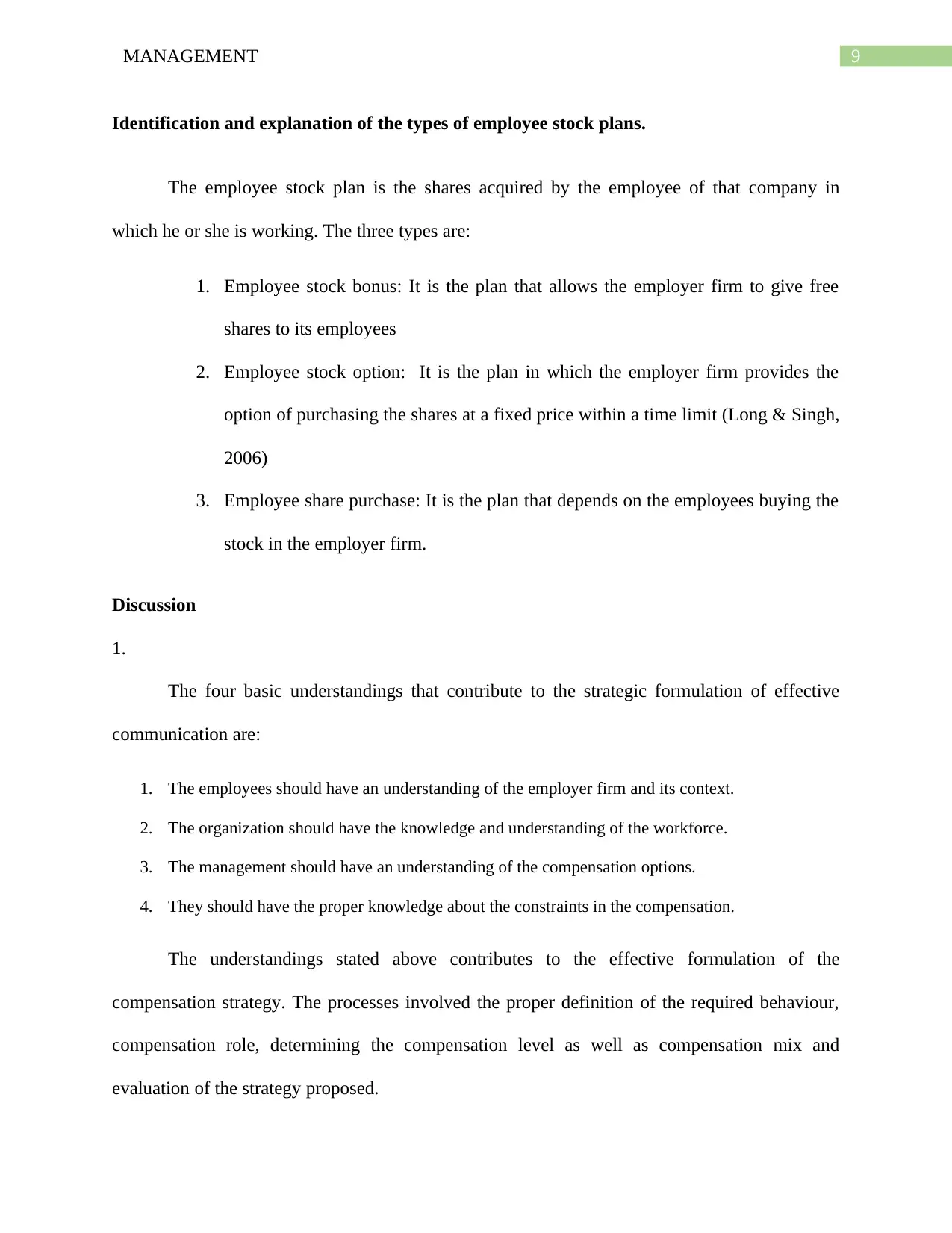
9MANAGEMENT
Identification and explanation of the types of employee stock plans.
The employee stock plan is the shares acquired by the employee of that company in
which he or she is working. The three types are:
1. Employee stock bonus: It is the plan that allows the employer firm to give free
shares to its employees
2. Employee stock option: It is the plan in which the employer firm provides the
option of purchasing the shares at a fixed price within a time limit (Long & Singh,
2006)
3. Employee share purchase: It is the plan that depends on the employees buying the
stock in the employer firm.
Discussion
1.
The four basic understandings that contribute to the strategic formulation of effective
communication are:
1. The employees should have an understanding of the employer firm and its context.
2. The organization should have the knowledge and understanding of the workforce.
3. The management should have an understanding of the compensation options.
4. They should have the proper knowledge about the constraints in the compensation.
The understandings stated above contributes to the effective formulation of the
compensation strategy. The processes involved the proper definition of the required behaviour,
compensation role, determining the compensation level as well as compensation mix and
evaluation of the strategy proposed.
Identification and explanation of the types of employee stock plans.
The employee stock plan is the shares acquired by the employee of that company in
which he or she is working. The three types are:
1. Employee stock bonus: It is the plan that allows the employer firm to give free
shares to its employees
2. Employee stock option: It is the plan in which the employer firm provides the
option of purchasing the shares at a fixed price within a time limit (Long & Singh,
2006)
3. Employee share purchase: It is the plan that depends on the employees buying the
stock in the employer firm.
Discussion
1.
The four basic understandings that contribute to the strategic formulation of effective
communication are:
1. The employees should have an understanding of the employer firm and its context.
2. The organization should have the knowledge and understanding of the workforce.
3. The management should have an understanding of the compensation options.
4. They should have the proper knowledge about the constraints in the compensation.
The understandings stated above contributes to the effective formulation of the
compensation strategy. The processes involved the proper definition of the required behaviour,
compensation role, determining the compensation level as well as compensation mix and
evaluation of the strategy proposed.
Secure Best Marks with AI Grader
Need help grading? Try our AI Grader for instant feedback on your assignments.

10MANAGEMENT
2.
The federal government passes the rules and regulations on all the federal employees and
the workers. The legislated constraints are employment standards, human rights legislation, tax
legislation and trade union legislation. Under the employment standards, the minimum standard
is set for payment and other employment conditions. Long and Singh, (2006) is of the view that
the human rights legislation based on gender, age or ethnicity prohibits discrimination in
employment. Tax legislation has a vital role in indirect pay. The trade union legislation
determines the parties’ right in a relationship of collective bargaining.
2.
The federal government passes the rules and regulations on all the federal employees and
the workers. The legislated constraints are employment standards, human rights legislation, tax
legislation and trade union legislation. Under the employment standards, the minimum standard
is set for payment and other employment conditions. Long and Singh, (2006) is of the view that
the human rights legislation based on gender, age or ethnicity prohibits discrimination in
employment. Tax legislation has a vital role in indirect pay. The trade union legislation
determines the parties’ right in a relationship of collective bargaining.
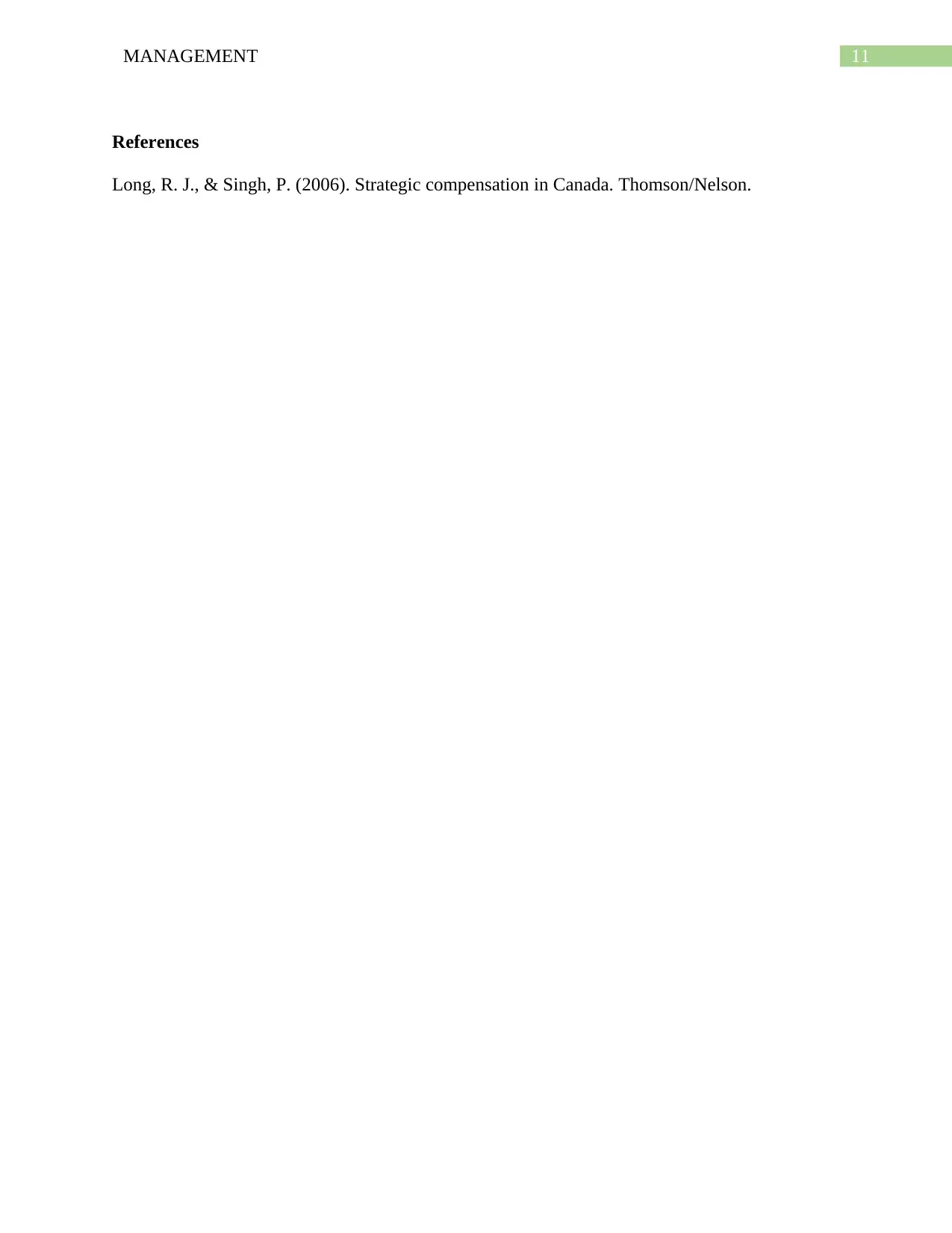
11MANAGEMENT
References
Long, R. J., & Singh, P. (2006). Strategic compensation in Canada. Thomson/Nelson.
References
Long, R. J., & Singh, P. (2006). Strategic compensation in Canada. Thomson/Nelson.
1 out of 12
Related Documents
Your All-in-One AI-Powered Toolkit for Academic Success.
+13062052269
info@desklib.com
Available 24*7 on WhatsApp / Email
![[object Object]](/_next/static/media/star-bottom.7253800d.svg)
Unlock your academic potential
© 2024 | Zucol Services PVT LTD | All rights reserved.




